When I first stepped into Prometheus Cave, I felt like I was entering another world. These are by far the largest and most awe-inspiring caves I’ve ever visited. Hidden in Tskaltubo, in Georgia, the cave reveals its magic through a 1.4 km walking trail and even a surreal boat ride on an underground river. Only six out of its twenty-two halls are open to the public, but they’re enough to leave you breathless. Between glittering stalactites, towering stalagmites and hidden waterfalls, every corner of the cave is a masterpiece sculpted by nature over millennia.
Table of Contents
Why You Should Visit Prometheus Cave in Georgia
Prometheus Cave is without question the most incredible cave I’ve ever visited. The impressive cave system offers an unforgettable underground adventure filled with stalactites, stalagmites, and subterranean rivers. The chambers are vast, almost cathedral-like, with stalactites and stalagmites that seem to rise and fall endlessly, shaped drop by drop over thousands of years.
PLAN YOUR TRIP TO GEORGIA
Stay online everywhere in Georgia with Holafly eSIM and enjoy unlimited data, fast internet, no roaming: perfect for using Google Maps and sharing your trip as you go.
Travel worry-free with Heymondo travel insurance, so you can enjoy every moment of your Georgian adventure without stress.
I followed the 1.4 km walking path, completely mesmerised, and in the highest cave, there was a show with classical music and lights. Inside, the air felt cleaner than anywhere I’ve breathed before. In fact, the Hall of Medea is well known for its pure, allergen-free atmosphere.
In the summer, the cave offers a fabulous retreat from the heat, maintaining a constant temperature of around 14 degrees Celsius. The final part, a boat ride on an underground river, was really exciting.
Despite the overtourism, mostly by local and Soviet tourists, Prometheus Cave is part of Georgia’s extensive network of protected areas, established to preserve unique, rare, and significant ecosystems, plant and animal species, natural formations, and cultural monuments.
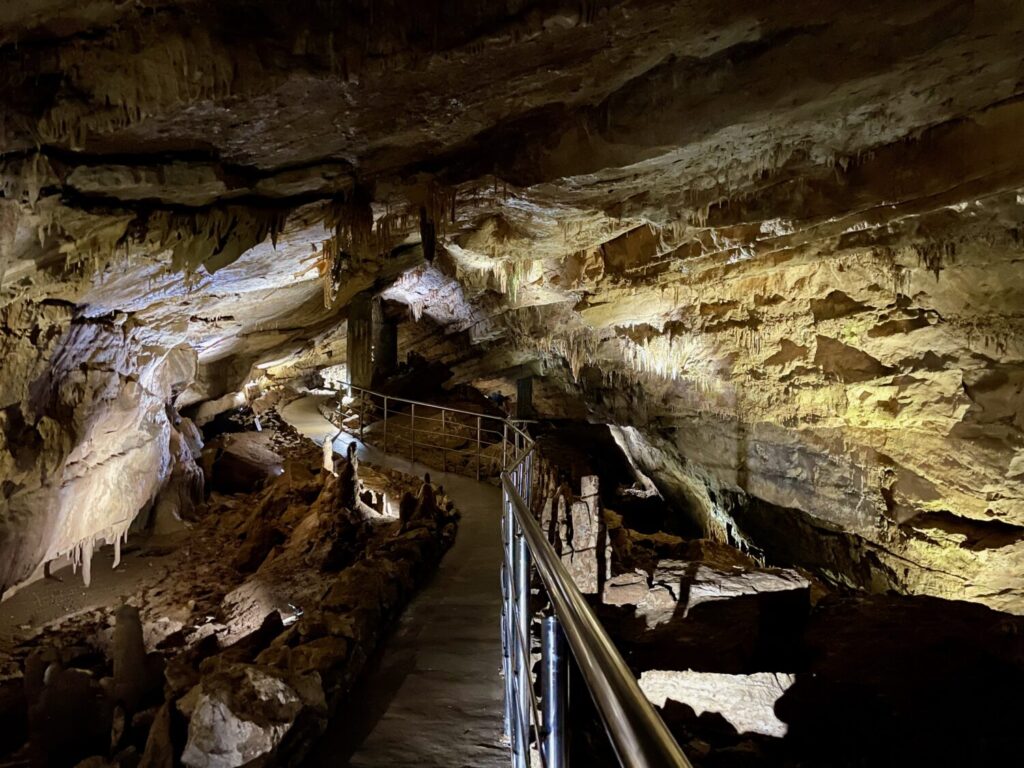
The Legend of Prometheus and the Cave’s Mythical Name
Prometheus Cave isn’t just a natural wonder; it’s wrapped in the timeless allure of mythology. The cave takes its name from Prometheus, the rebellious Titan of Greek legend who defied the gods by stealing fire and giving it to humankind. For this act, Zeus sentenced him to eternal punishment, chained to a rock in the Caucasus Mountains.
According to Georgian tradition, this very cave lies near the site of his suffering, adding a mythical dimension to the experience. While the connection is more symbolic than literal, it casts a spell over your visit.
As you move through the vast, echoing chambers, illuminated by shifting coloured lights, it’s easy to imagine ancient forces still at work deep beneath the earth. The rhythmic drip of water and the stillness inside the cave create a mood that feels almost sacred, as though you’ve stepped into the pages of an old legend.
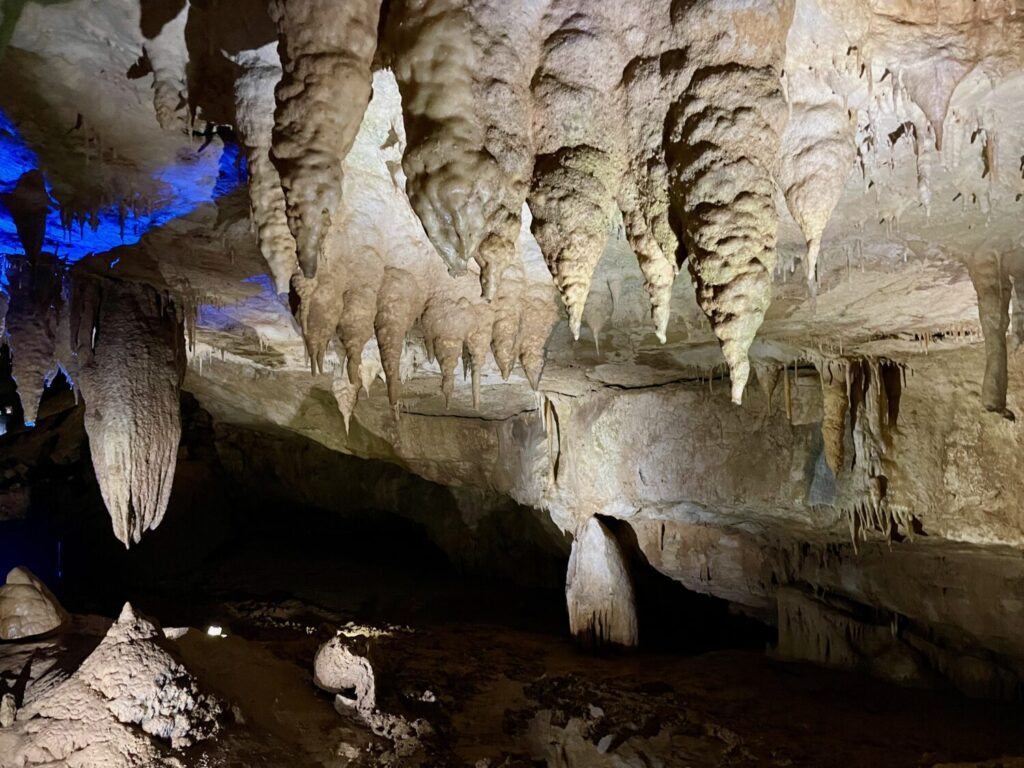
Discovery of Prometheus Cave and Its Geological Wonders
In the 1980s, speleologists from the Institute of Geography of Georgia discovered the Tskaltubo cave system. At the time, they named it Kumistavi Cave, after the river flowing through it. Even today, only about 30 kilometres of the cave have been explored, just half of its estimated full length!
In 1985, the Georgian government decided to turn the cave into a tourist destination. Work moved quickly: by 1989, they had created a 1-kilometre walking route, added stairs and paths, dug a 150-metre tunnel for the exit, and started building visitor facilities on the surface.
But in 1990, the project was abandoned due to the collapse of the Soviet Union.
The idea resurfaced in 2007, when the Georgian government rekindled its interest in opening the cave to the public. During a visit in 2010, President Mikheil Saakashvili supported the development and suggested a new name: Prometheus Cave. According to local legend, Prometheus was chained to the nearby cliffs of Khvamli as punishment for giving fire to humanity.
Finally, in 2011, after decades of delays and setbacks, Prometheus Cave officially opened to the public, offering a spectacular glimpse into Georgia’s underground wonders.
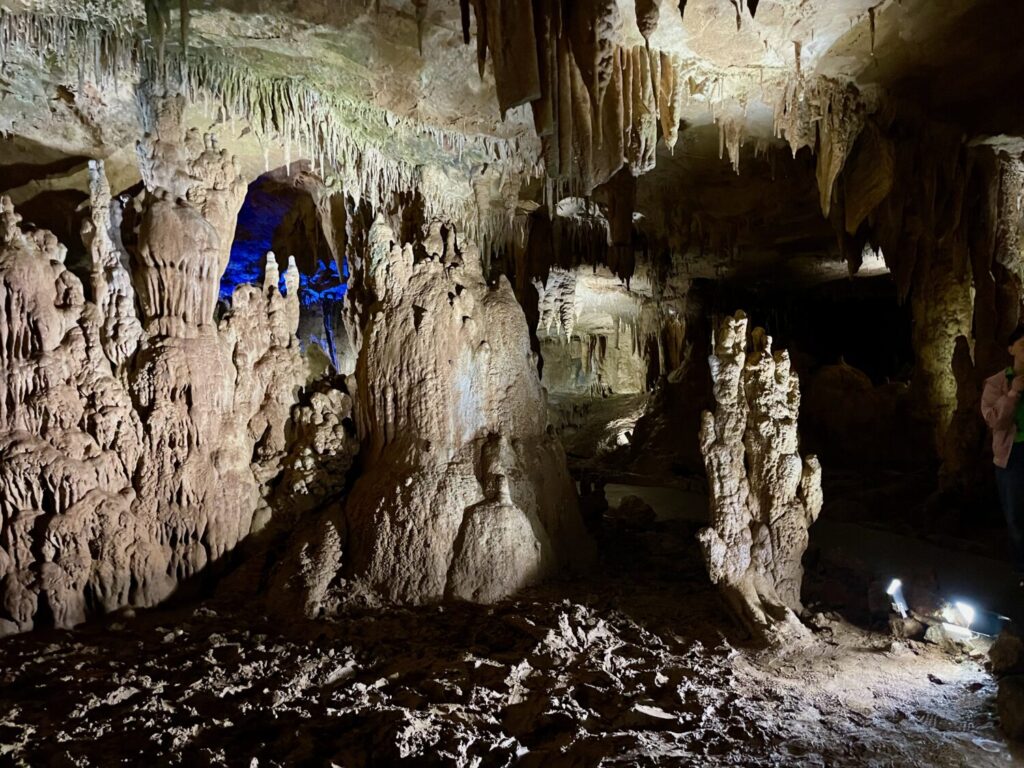
Geological Wonders of the Sataplia–Tskaltubo Limestone Massif
The landscape around Prometheus Cave isn’t just beautiful; it’s incredibly ancient. The Sataplia–Tskaltubo limestone massif, located in Georgia’s Imereti region, is part of the Imereti Uplift zone, and dates back to the Jurassic period. Over millions of years, tectonic shifts and erosion have sculpted an underground world full of surprises.
Here, nature has shaped a classic karst landscape, complete with sinkholes, underground rivers, disappearing streams, and horizontal caves. However, it’s not just dramatic scenery; this area is also rich in natural resources. Locals have long valued the region for its limestone and dolomite, healing mineral waters, and even semi-precious stones like jasper, chalcedony, and agate.
How Prometheus Cave Was Formed: A Karst Process
Prometheus Cave forms from karstification. Over time, carbon dioxide in the soil, combined with rainwater, forms a mild acid. This acidic water slowly dissolved the limestone, creating cracks, tunnels, and vast caverns.
The process is incredibly slow, but after thousands of years, it leaves behind some truly spectacular results, as you can see for yourself walking in the Prometheus Cave!
Flora and Fauna in the Sataplia Nature Reserve
Above ground, the nearby Sataplia Nature Reserve is a lush and peaceful place. Covered almost entirely by the Colchic forest, it’s home to beech, boxwood, and hornbeam trees, along with more than 100 woody plant species, many of which are rare or endangered.
Inside the caves, life thrives too. You’ll find ferns, mosses, fungi, and algae, plus hundreds of invertebrates, rare crustaceans, and even the endemic Troglocharis kutaissiana, a tiny freshwater shrimp you won’t find anywhere else in the world.
What to Expect Inside Prometheus Cave: Stalactites, Lights and Underground Rivers
Exploring Prometheus Cave is a truly unforgettable experience. The 1.4-kilometre walking route takes about an hour. You descend 80 metres below ground, navigating a series of stairways and well-lit paths that connect six impressive halls, each with its own character and geological wonders.
The temperature inside the cave ranges from 10°C to 15°C, making it pleasantly cool in summer but rather chilly in other seasons. What makes this cave stand out is not just the sheer scale, but also the way it’s presented.
Almost at the end of the walking path, a large grotto with stalactites and stalagmites is illuminated by coloured lights, accompanied by classical music playing softly in the background, creating a magical, almost theatrical atmosphere.
At the end of the route, you have the chance to take a five-minute boat ride through an underground river. I chose the ticket with the boat trip, and the experience was absolutely unique, making it the perfect end to an extraordinary visit.
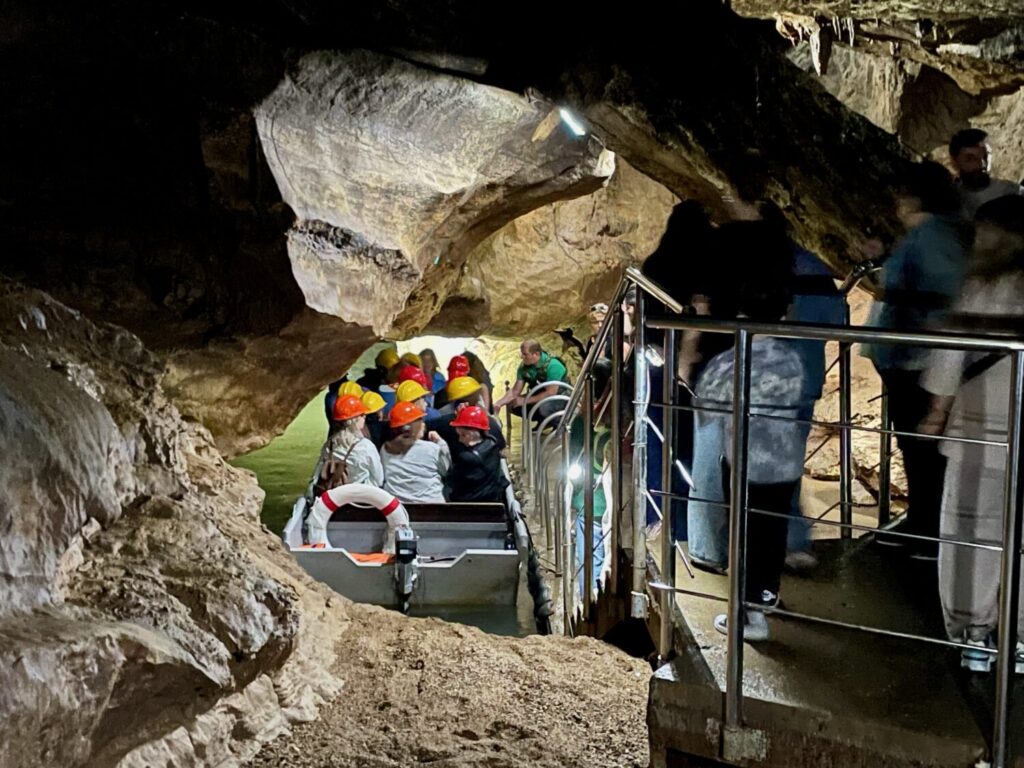
Prometheus Cave Tour: What’s Included and What to Know
A visit to Prometheus Cave is an unforgettable experience, but be prepared to share it with many others. You don’t need to plan much in advance, as everything is extremely well organised.
The visit runs like clockwork, part of an impeccable tourist machine designed to welcome hundreds of visitors each day. In fact, that’s also one of its drawbacks: overtourism.
Our group was very large, made up mostly of Georgian and post-Soviet tourists. We also encountered plenty of school groups along the way. The guide speaks both English and Georgian, but moves very quickly, rarely waiting for the group to reassemble. It’s easy to feel left behind or miss parts of the explanation if you’re not close to the front.
The walking route is manageable if you’re in good shape. It includes 880 steps, some of them quite steep, and the path can be slippery, especially in more humid areas. The trail is not accessible for visitors with reduced mobility. If you’re interested in the boat ride at the end, keep in mind that tickets are sold separately.
Despite the crowds, I was amazed by the sheer scale and beauty of the cave, the largest I’ve ever seen. The light and sound show is surprisingly elegant, with classical music enhancing the atmosphere in a way that feels natural and far from kitsch.
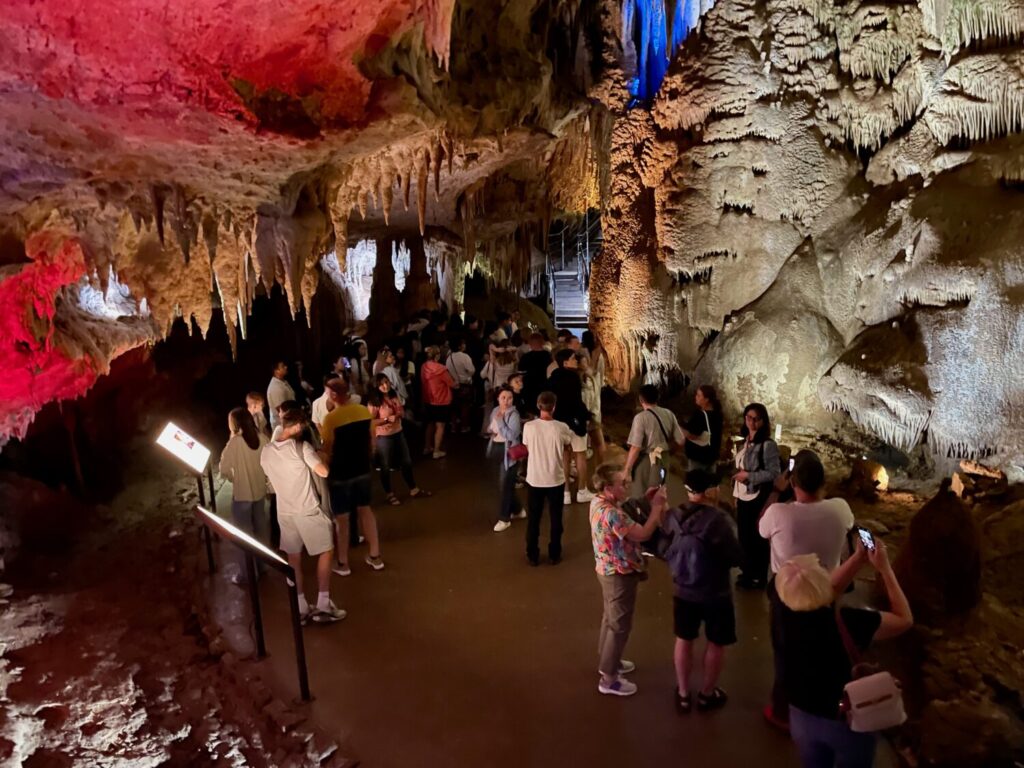
Essential Tips for Visiting Prometheus Cave, Georgia
Prometheus Cave is open year-round, with seasonal opening hours and guided tours only. Entry is limited to a set number of visitors, so it’s best to arrive early, especially during weekends or school holidays.
I recommend wearing closed, non-slip shoes and bringing a light jacket or jumper, as temperatures inside stay between 10°C and 15°C. I was fine in a T-shirt, but it was an exceptionally hot day outside.
Prometheus Cave Tickets, Opening Times and Visitor Information
Prometheus Cave is open all year round. It’s closed only on Mondays, so please plan your visit accordingly. Opening hours vary depending on the season:
- January, February, March, November, December: from 10:00 am to 5:00 pm
- April, October: from 10:00 am to 5:30 pm
- May to September: from 10:00 am to 6:00 pm
You can visit the cave only with guided tours departing every 20 minutes. Entrance with the guide and the final boat tour costs 45 GEL, approximately €15, payable by card at the ticket office. However, prices might soon rise because it is a highly popular destination.
Tours should be available in Georgian, English, and Russian. My guide conducted the tour in Georgian and English. However, she moved so quickly that it was easy to miss parts of the explanation.
I bought my ticket on-site because I couldn’t find how to buy it online. International websites like Viator and GetYourGuide do not offer single entrance tickets. Instead, they list guided tours from Kutaisi or Tbilisi, often combining Prometheus Cave with other attractions like Okatse and Martvili Canyons. These tours are a good option if you want a structured day with transportation included, but may not be ideal if you prefer to explore independently.
At the entrance, there was a sign pointing to guru.ge, a Georgian website where you can supposedly purchase tickets online. However, buying tickets at the counter works totally fine. Just be aware that entry is limited to a set number of visitors. During peak times, you might have to wait.
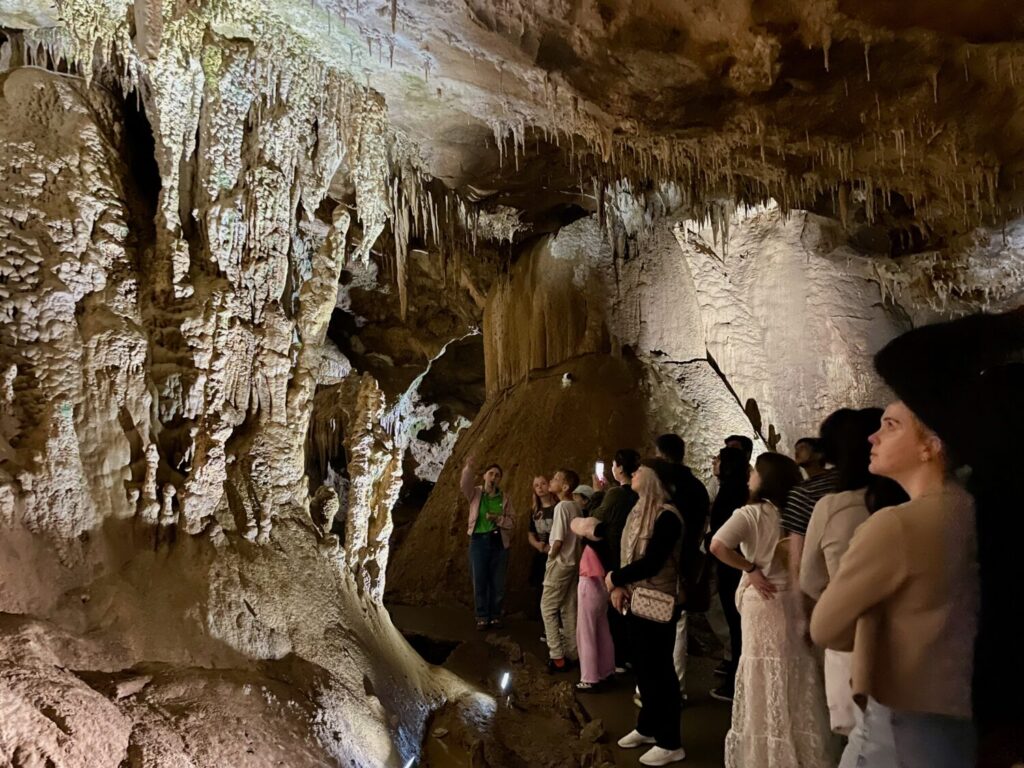
How to Get to Prometheus Cave
Prometheus Cave is located in the village of Kumistavi, in the Tskaltubo municipality of western Georgia. It lies about 20 kilometres from Kutaisi, the region’s main city. You can easily reach the cave by car or organised tour.
The cave is well signposted, and the drive through the surrounding countryside is pleasant, passing through green hills and quiet villages. If you’re travelling by car, it takes roughly 30 minutes from Kutaisi.
Renting a car is a convenient option, especially if you plan to explore other attractions in Georgia. There’s a large parking area near the visitor centre, and the road is paved and in good condition. The only problem is that you can only pay for parking by cash, and there is no ATM on-site.

If you prefer using public transport, minibuses leave regularly from Kutaisi Central Bus Station to Tskaltubo. From there, you’ll need to take a taxi or arrange a lift to Kumistavi village, which is about 6 kilometres from the town centre. While it’s not complicated, the journey can be time-consuming and less comfortable than going by car.
If you prefer everything organised, several tour companies in Kutaisi and Tbilisi offer day trips to Prometheus Cave, often combined with other natural sights. These tours typically include transportation, a guide, and entrance fees, making them a stress-free option.
Where to Stay Near Prometheus Cave: Accommodation Guide in Tskaltubo and Kutaisi
If you’re planning a visit to Prometheus Cave, choosing the right place to stay can make your trip even more enjoyable. The cave is located near Tskaltubo, a historic spa town just 20 minutes by car from Kutaisi, Georgia’s second-largest city. Both towns offer a range of accommodation options to suit different styles and budgets.
Tskaltubo is ideal if you want to stay close to the cave and enjoy a quieter, more relaxing atmosphere. Known for its grand Soviet-era sanatoriums and healing mineral waters, the town is currently undergoing a revival, with several hotels and wellness resorts now open to travellers.
Kutaisi, on the other hand, offers more variety when it comes to restaurants, nightlife, and transport links. It’s a great base if you’re travelling by public transport or looking for a livelier Georgian city experience.
Tskaltubo Epic Hotel & Spa: Luxury Stay Minutes from the Cave
During my trip, I stayed at the Tskaltubo Epic Hotel & Spa, and I couldn’t recommend it more. The rooms were spacious and modern, and the spa facilities perfect after a day of exploring the cave.
Best of all, the hotel is conveniently located just minutes from Prometheus Cave. It’s the ideal base if you seek both comfort and convenience. The boat trip ends in the hotel yard, and the hotel itself organises more boat trips around.
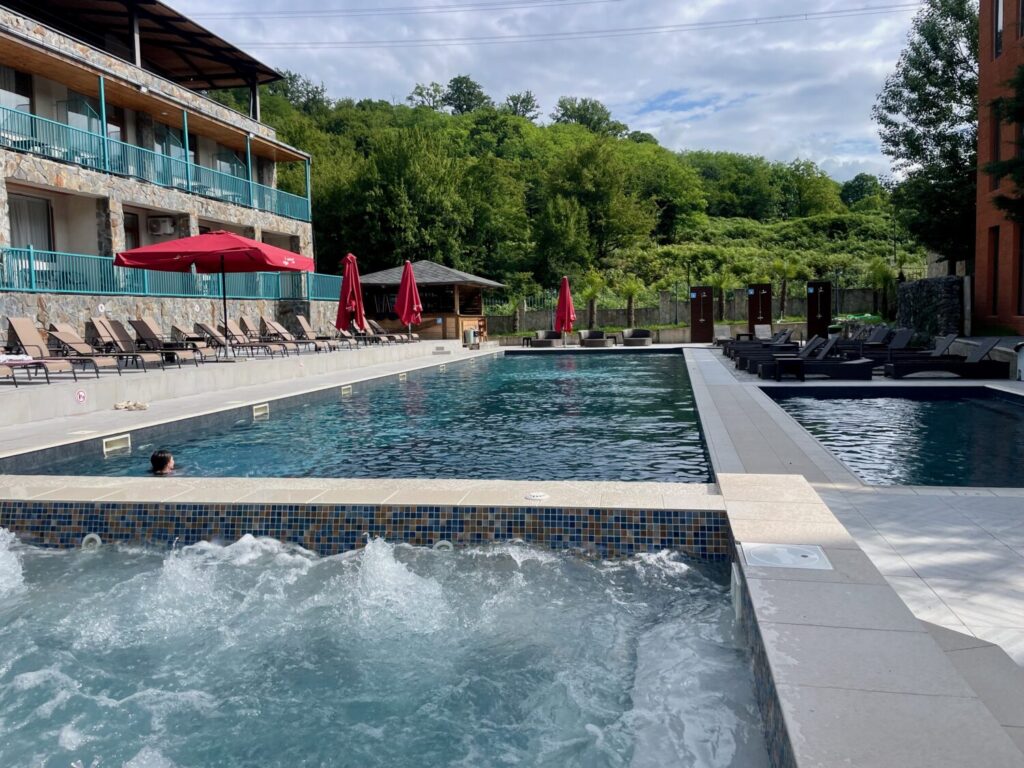
Top Things to Do Near Prometheus Cave: Explore Tskaltubo’s Soviet Sanatoriums, Historic Kutaisi and More Natural Wonders
If you’ve already explored Prometheus Cave, the surrounding region offers plenty more to see and do. Just a few minutes away is Tskaltubo, once a famous spa resort during the Soviet era.
The town is still dotted with grand, abandoned Soviet sanatoriums. Some have been partially restored, others left as haunting reminders of a bygone era. Many visitors enjoy strolling around these architectural relics, which lend Tskaltubo a unique, almost nostalgic atmosphere.

From Tskaltubo, it’s easy to continue your journey to Kutaisi, one of Georgia’s oldest cities. Kutaisi combines history, culture, and local charm, making it a perfect stop before or after visiting the caves.
You can wander through the Bagrati Cathedral, a UNESCO World Heritage Site. Or explore the colourful Green Bazaar to sample fresh produce and traditional Georgian snacks. If you enjoy a bit of history, don’t miss the Gelati Monastery, another UNESCO World Heritage Site. It’s just a short drive from the city centre.
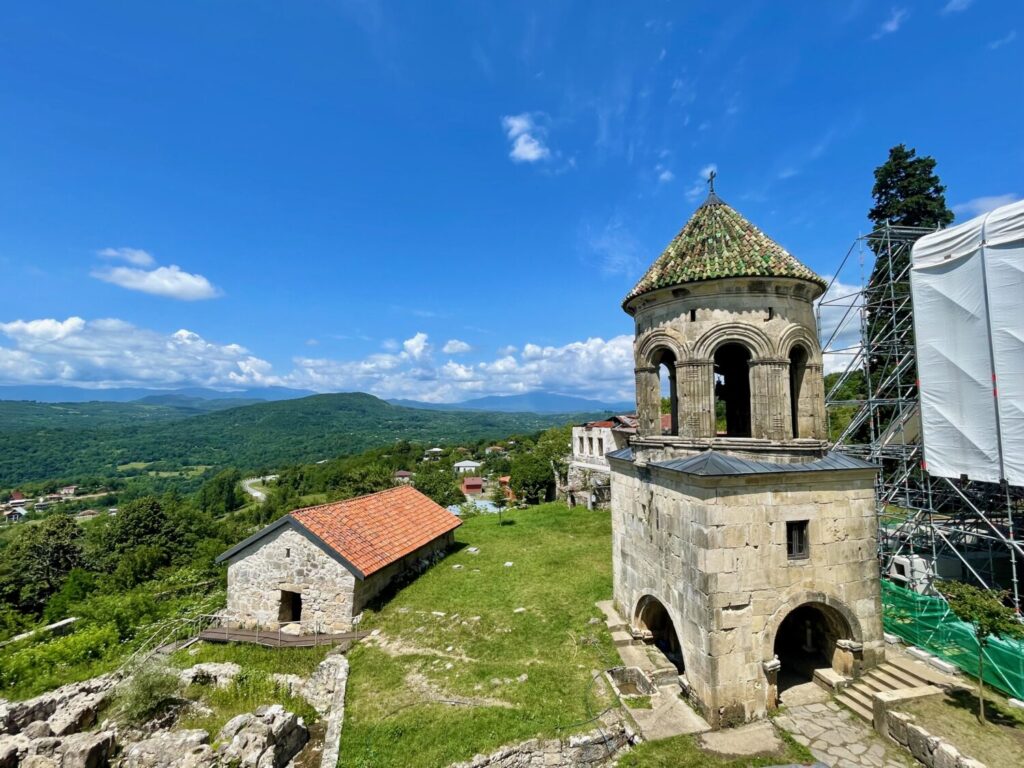
For a deeper dive into the region’s natural beauty, you can also book day trips combining Prometheus Cave with Okatse Canyon and Martvili Canyon, where you can walk along hanging bridges or take boat rides through breathtaking gorges.
Prometheus Cave is more than just an underground attraction; it’s a journey into the heart of Georgia’s natural and cultural heritage. From the awe-inspiring rock formations to the echoes of myth and legend, every step through the cave invites you to slow down and marvel. Feel free to share in the comments if you have already visited Prometheus Cave or are planning to go.
